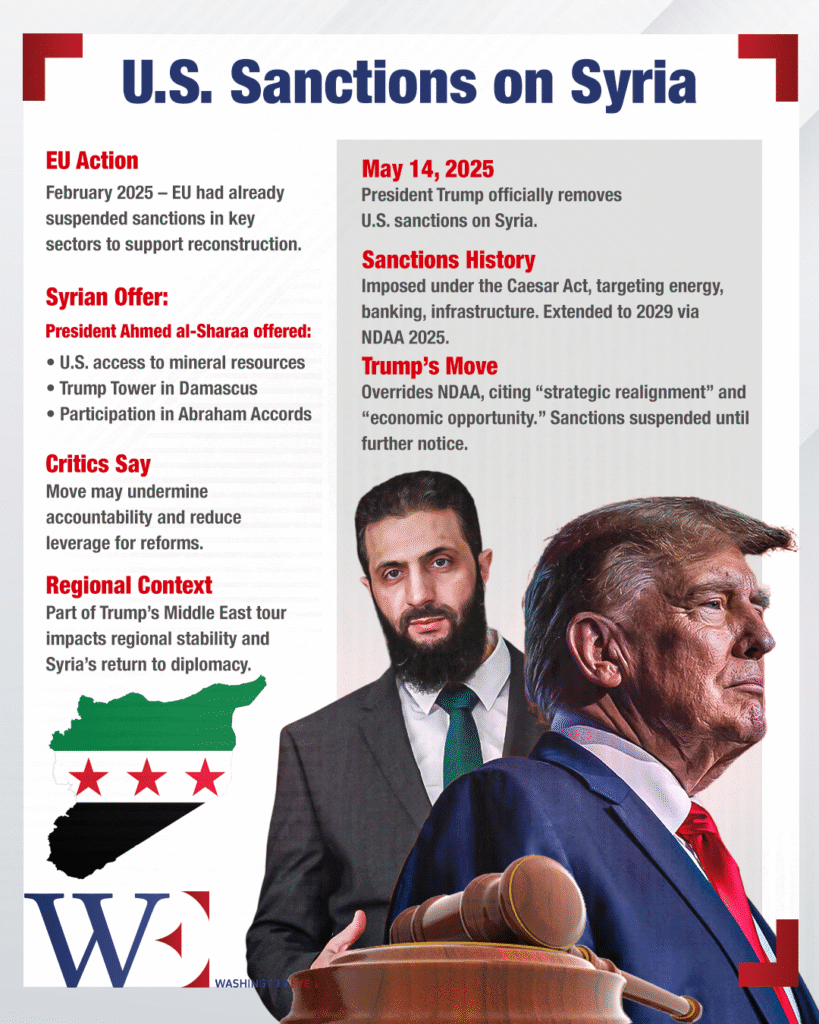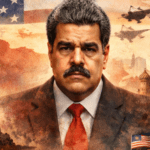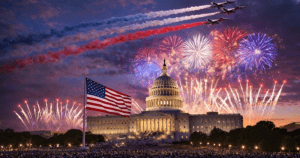History was made in Riyadh this week—not with warplanes or peace treaties, but with a handshake and a pivot. On May 13, 2025, President Donald Trump stood onstage at a high-profile investment forum in Saudi Arabia and announced what many believed unthinkable: the full and immediate lifting of U.S. sanctions on Syria.
The Caesar Syria Civilian Protection Act, long the cornerstone of Washington’s pressure campaign on Damascus, is now history. So too are the layered restrictions on energy, banking, and infrastructure, renewed only months ago through the 2025 National Defense Authorization Act. Overnight, Syria transitioned from global pariah to potential investment frontier.
The timing was no accident. With Saudi Crown Prince Mohammed bin Salman and Turkish President Recep Tayyip Erdoğan at his side, Trump declared the end of America’s economic war on Syria, praising its new president, Ahmed al-Sharaa, as “a tough guy with a real shot” at rebuilding the country. This was more than diplomatic theater—it was a calculated geopolitical move aimed at resetting America’s leverage in the Middle East.
The decision opens the door to long-delayed reconstruction efforts in a country where over $400 billion in damage remains untouched. It also hands U.S. companies—especially in the oil, mineral, and telecommunications sectors—a front-row seat at Syria’s revival. Notably, al-Sharaa has already offered American firms exclusive access to rare earth mineral fields, energy zones, and even greenlit exploratory talks on building a Trump Tower in Damascus.
Syria’s foreign minister called the lifting of sanctions “a new start.” From Washington to Dubai, business leaders are quietly mobilizing. In a region increasingly shaped by Gulf capital and Chinese infrastructure, America has thrown its hat back into the ring.
But not without controversy.
Human rights groups and U.S. lawmakers, particularly from within the Senate Foreign Relations Committee, are warning that lifting sanctions without verifiable political reform risks normalizing impunity. Syria’s track record under Bashar al-Assad, whose ouster in late 2024 remains a recent memory, includes war crimes, mass detentions, and the widespread use of chemical weapons. For critics, Trump’s move feels less like realpolitik and more like selective amnesia.
Yet realpolitik is precisely the point.
Trump’s foreign policy—love it or loathe it—has always been transactional. Sanctions are a tool, not a doctrine. With Russia overstretched in its conflict with NATO and Iran diplomatically cornered, the U.S. sees in Syria a moment of rare opportunity: a new leader, a fractured power vacuum, and a regional appetite for economic reintegration.
The strategic implications are immense. By embracing Syria’s transition, Trump is simultaneously undercutting Iranian influence, courting Turkish cooperation, and solidifying his bond with the Gulf. Add to this a staggering $600 billion investment commitment he secured from Saudi Arabia during the same visit, and it becomes clear: Trump is building a new architecture in the region—one rooted in business, not bullets.
What remains uncertain is whether Syria can deliver.
Ahmed al-Sharaa’s rise may have ended Assad’s reign, but it hasn’t erased decades of entrenched corruption, sectarian tension, or militia control. U.S. investment alone cannot guarantee stability. And while Washington may be willing to look forward, Syrians on the ground have not forgotten the past. Political legitimacy will not be granted by foreign dignitaries—it must be earned at home.
Still, for the first time in over a decade, there is oxygen in the room. Damascus is being talked about as a place to build, not just bomb. If managed wisely, the lifting of sanctions could mark a turning point—not just for Syria, but for how the U.S. re-engages with post-conflict states in an era of multipolar competition.
This isn’t a peace deal. It’s a bet. A high-stakes one. But in the Middle East, sometimes peace begins with a transaction—and the world may soon find out whether Trump’s gamble on Syria will pay off.
















